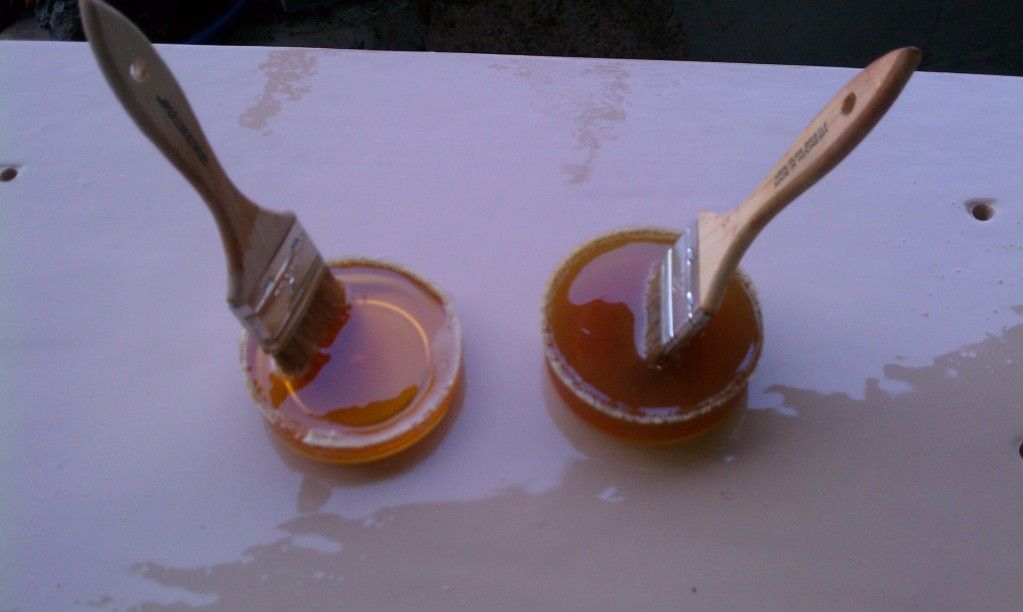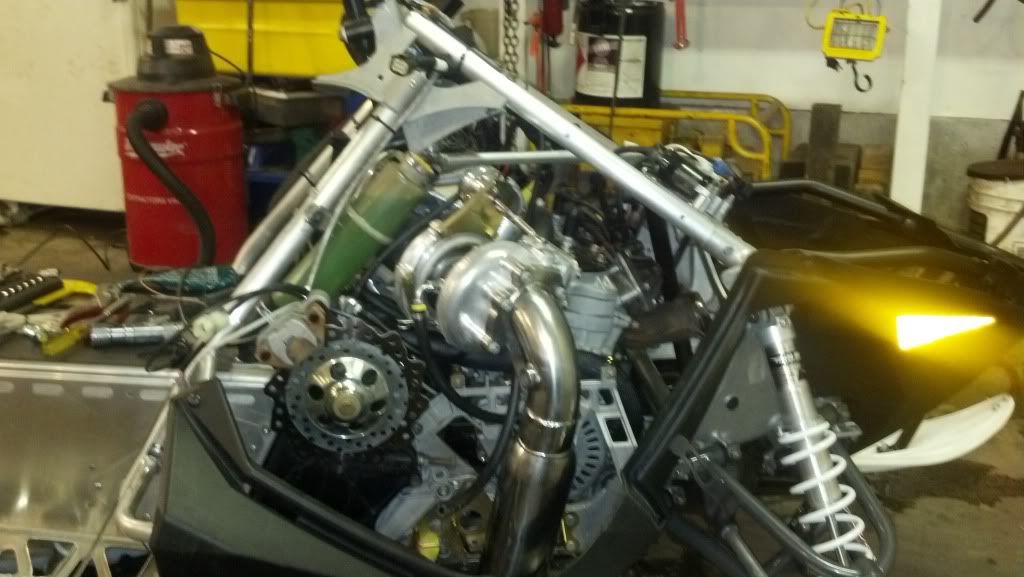- Joined
- Oct 25, 2011
- Messages
- 25,237
Re: 79 ski supreme
I'm not sure what the 'slot it to make theit flex' refers to, but for the rest of the above:
You can do it the way you described, but make sure you're pre-wetting the fiberglass on plastic so you can use the plastic to carry & layout the wet glass. It may tend to stretch/fray/pull apart while handling w/ the wet resin, plus it's heavier wet then dry. Some find that getting the fiberglass materials well adhered & fully wetted out is easier when done this way:
Wet out the wood w/ resin, when it starts to tack over (NOT dry) roll out another coat of resin & layup the dry fiberglass into the wet resin, then use a bubble buster roller to fully wet out the applied glass. This can be done out of the boat for all wood going into the boat. Doing this out of the boat, allows you to fully cover the plywood faces & the edges. The edges are very susceptable to water intrusion, so IMHO, they need to be well covered w/ resin & cloth (CSM). Then when you install the wooden pieces, they already have 1 layer of resin & glass to attempt to improve the water resistance. Some do it this way, some don't.....
Once installed into the boat, stringers bedded in PB or PL, transom adhered to the fiberglass transom skin w/ PB or PL (WoodOnGlass has good pix & descriptions of another iboater's transom clamps, but many of us still refer to them as WOG's clamps), and you've made the fillets (PB or PL) you tab the wood onto the hull bottom & sides with shorter pieces of glass, done the same way, only no pre-wet of the wood, just roll on resin, apply dry glass 'tabs' and roll to wet out & remove bubbles. Friscoboater has video's in his threads & on his YouTube channel that 'show' a lot of these steps & they helped pull it together & have it make more sense to me. Once the bedding kicks you can fillet, while the fillets are still tacky you can start tabbing, or wait until they have kicked. Once the tabs are tacky you can start laying up full coverage resin & glass. When you lay additional resin & glass over still tacky previous work, it is generally referred to as Wet on Wet layups.
The tabs are just to hold the parts in place while you layup full coverage.
And many think the wet on wet application makes for stronger overall fiberglass work, the layups all cure as 1 thicker 'unit'. The additional layups also make the resin cure at a higher temp which increases the strength & bond of the fiberglass & resin. Yes, it CAN get too hot, so you need to pay attention & keep track of what areas have 1, 2 or 3 layers of kicking resin, because you can OVER heat the resin & make it weaker not stronger.
Wet on Wet should allow you to mix & more completely use each batch of resin you make, they make neat modern art sculptures, but do you want to make a bunch of these w/ any of the resin you buy:

And by working your way around the different areas of the boat, 1 outside stringer, then the other, central stringer, back to 1st stringer, 2nd stringer, back to central.... You can layup as about as much resin & glass as your physically able to, working hunched over in the boat.
If the resin kicks & is dry, you should rough & scuff those areas, vacuum off the dust & wipe the area down w/ acetone before applying the next layup. If is only to create adhesion between the layer, you don't want to over sand & expose the fiberglass, and definitely don't want to sand thru the fiberglass...
NOTE: Bedding & filleting w/ PB is going to allow you to move along to the next step much quicker then if you use PL. PL needs at least 72hrs to off gas & stop bubbling up as it cures. So that's a 3 day wait to start filleting in the stringers after you bed them, and another 3 days after you fillet to start tabbing.
For the above, the 1st layer of resin & glass, applied out of the boat, is CSM. The tabbing is 1708, then alternate a layer of CSM w/ a layer of 1708 for full coverage. You can then add as many layers of CSM & 1708 as necessary to get approximately the same overall thickness of resin & glass as was used originally. Each following layer needs to extend several inches further out onto the adjoining hull surface then the previous. The existing glass should be ground down to expose good glass far enough to allow this staggered/feathered edge of staggered glass. Before the initial layup vac the entire hull & wipe it all down with acetone. As you prep to install resin & glass, wipe each area for the current layup down again w/ acetone.
You'll need to be aware of the status of your respirator's filters. You need to change them as soon as you can detect the smallest hint of the resin's odor. And make sure the filters are rated for the poly fumes. I can't remember the 'approved' filter designation, but poly resin contains Styrene. So you'll want to make sure to be working in a well ventilated area....
I didn't intend to be this long ^^^ & wordy.... You should be able to cross check the above in several different threads. I'm really more of an ex-pert
i found some doug fir underlayment on the third attempt but im an idiot and bought the wrong thickness! man im good! so going back tomarrow and get some 5/8. slot it to make theit flex
so i wet the new wood, wet some glass, and apply it to the wood on both sides, wet the transum, then clamp it to the transum and let it dry. then "tab" the new piece in around the perimiter??
I'm not sure what the 'slot it to make theit flex' refers to, but for the rest of the above:
You can do it the way you described, but make sure you're pre-wetting the fiberglass on plastic so you can use the plastic to carry & layout the wet glass. It may tend to stretch/fray/pull apart while handling w/ the wet resin, plus it's heavier wet then dry. Some find that getting the fiberglass materials well adhered & fully wetted out is easier when done this way:
Wet out the wood w/ resin, when it starts to tack over (NOT dry) roll out another coat of resin & layup the dry fiberglass into the wet resin, then use a bubble buster roller to fully wet out the applied glass. This can be done out of the boat for all wood going into the boat. Doing this out of the boat, allows you to fully cover the plywood faces & the edges. The edges are very susceptable to water intrusion, so IMHO, they need to be well covered w/ resin & cloth (CSM). Then when you install the wooden pieces, they already have 1 layer of resin & glass to attempt to improve the water resistance. Some do it this way, some don't.....
Once installed into the boat, stringers bedded in PB or PL, transom adhered to the fiberglass transom skin w/ PB or PL (WoodOnGlass has good pix & descriptions of another iboater's transom clamps, but many of us still refer to them as WOG's clamps), and you've made the fillets (PB or PL) you tab the wood onto the hull bottom & sides with shorter pieces of glass, done the same way, only no pre-wet of the wood, just roll on resin, apply dry glass 'tabs' and roll to wet out & remove bubbles. Friscoboater has video's in his threads & on his YouTube channel that 'show' a lot of these steps & they helped pull it together & have it make more sense to me. Once the bedding kicks you can fillet, while the fillets are still tacky you can start tabbing, or wait until they have kicked. Once the tabs are tacky you can start laying up full coverage resin & glass. When you lay additional resin & glass over still tacky previous work, it is generally referred to as Wet on Wet layups.
The tabs are just to hold the parts in place while you layup full coverage.
And many think the wet on wet application makes for stronger overall fiberglass work, the layups all cure as 1 thicker 'unit'. The additional layups also make the resin cure at a higher temp which increases the strength & bond of the fiberglass & resin. Yes, it CAN get too hot, so you need to pay attention & keep track of what areas have 1, 2 or 3 layers of kicking resin, because you can OVER heat the resin & make it weaker not stronger.
Wet on Wet should allow you to mix & more completely use each batch of resin you make, they make neat modern art sculptures, but do you want to make a bunch of these w/ any of the resin you buy:

And by working your way around the different areas of the boat, 1 outside stringer, then the other, central stringer, back to 1st stringer, 2nd stringer, back to central.... You can layup as about as much resin & glass as your physically able to, working hunched over in the boat.
If the resin kicks & is dry, you should rough & scuff those areas, vacuum off the dust & wipe the area down w/ acetone before applying the next layup. If is only to create adhesion between the layer, you don't want to over sand & expose the fiberglass, and definitely don't want to sand thru the fiberglass...
NOTE: Bedding & filleting w/ PB is going to allow you to move along to the next step much quicker then if you use PL. PL needs at least 72hrs to off gas & stop bubbling up as it cures. So that's a 3 day wait to start filleting in the stringers after you bed them, and another 3 days after you fillet to start tabbing.
For the above, the 1st layer of resin & glass, applied out of the boat, is CSM. The tabbing is 1708, then alternate a layer of CSM w/ a layer of 1708 for full coverage. You can then add as many layers of CSM & 1708 as necessary to get approximately the same overall thickness of resin & glass as was used originally. Each following layer needs to extend several inches further out onto the adjoining hull surface then the previous. The existing glass should be ground down to expose good glass far enough to allow this staggered/feathered edge of staggered glass. Before the initial layup vac the entire hull & wipe it all down with acetone. As you prep to install resin & glass, wipe each area for the current layup down again w/ acetone.
You'll need to be aware of the status of your respirator's filters. You need to change them as soon as you can detect the smallest hint of the resin's odor. And make sure the filters are rated for the poly fumes. I can't remember the 'approved' filter designation, but poly resin contains Styrene. So you'll want to make sure to be working in a well ventilated area....
I didn't intend to be this long ^^^ & wordy.... You should be able to cross check the above in several different threads. I'm really more of an ex-pert





















